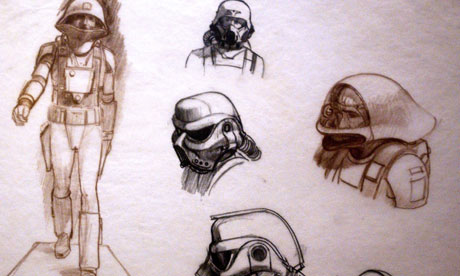
George Lucas may have thought up the Star Wars series, but it would have looked very different without the imaginative breadth of the conceptual artist Ralph McQuarrie, who has died aged 82. McQuarrie's style was characterised by competing strains of industrial realism and aesthetic grandeur. "I've always had sort of a dreamworld approach to sitting and sketching for myself," he said. "I go for the romantic and what looks interesting while half my mind is occupied with practicality."
Nowhere was this more apparent than in his design of Darth Vader, the terrifying Dark Lord from the Star Wars films. "The first thing I thought was, 'Shouldn't he have some sort of breathing apparatus if he's entering the vacuum of space?' I asked George and he said, 'Fine, give him a breath mask.'" A movie legend was born, along with millions of childhood nightmares.
In the eight years it took to make the first Star Wars trilogy, various artists translated Lucas's ideas into sketches and paintings. However, McQuarrie was there from the beginning. Recruited by the filmmaker in 1975, he originated or modified the look of many of the movies' key characters, including the Yeti-like "Wookiee" Chewbacca and the androids R2-D2 and C-3PO, and worked on sets and matte paintings for the trilogy.
McQuarrie also designed spacecraft for Steven Spielberg on Close Encounters of the Third Kind (1977) and E.T. – The Extra-Terrestrial (1982), as well as the aliens in Cocoon (1985). He was part of the four-strong team that won an Academy award for its visual-effects work on the latter movie.
McQuarrie was born in Gary, Indiana, and raised on a farm in Montana. His family then moved to the west coast and on to Vancouver, Canada, where he enrolled at a technical school. While serving in the military during the Korean war, he survived a bullet to the head.
Returning to the US, he studied at California's Art Centre College of Design and then took a series of design-oriented jobs. He illustrated books, drew teeth and instruments for a dental firm, prepared aerodynamic illustrations for Boeing, storyboarded educational films and provided animated segments for CBS News.
Two up-and-coming filmmakers, Matthew Robbins and Hal Barwood, hired him to contribute designs for their science-fiction script Star Dancing. Although the project was never made, his designs were seen by Lucas, who was then nurturing an idea for a science-fiction adventure movie.
"Darth, R2-D2 and all of that came out of those first three or four weeks in early 1975," said McQuarrie. "George gave me a script and I went away for a while. He said, 'Do what interests you.' It was like hearing music and seeing what you hear."
Released in 1977, Star Wars broke box-office records and changed cinema forever, for both good and ill. McQuarrie's designs, functional but often beautiful, were central to the film's character, and led to other offers within the science-fiction genre, including the television series Battlestar Galactica (which he worked on until the show's overlap with the Star Wars universe became too pronounced).
When Spielberg asked him to design the mothership for the climax of Close Encounters, the artist drew on a dream from years earlier, in which he had seen an awe-inspiring spacecraft with pipes and stairways jutting out from its underside. Spielberg turned that concept on its head, so that the protuberances were now crowded onto the top of the ship like a tightly-packed metropolis.
McQuarrie often relied on the unconscious part of his mind to generate inspiration. "I used to try squeezing work out, but it's like toothpaste in a tube that will only come out so fast … There's no point pounding my brain – the best thing I can do is collect my thoughts as soon as I'm told what's needed. Then I lie down and let it gel unconsciously. I sort of semi-sleep, and somewhere along the way of going to sleep or coming out of it, I get exactly what I need – it's just there, rising like the bubbles in champagne from somewhere inside."
On the second and finest Star Wars picture, The Empire Strikes Back (1980), McQuarrie's responsibilities were greatly increased. Most of the movie's new elements (including a frozen planet called Hoth and a city floating in the clouds) bore his imprint; Lucas even named a minor character after him. But fewer of his ideas made the cut in Return of the Jedi (1983), and he seemed to be experiencing some fatigue. "It became less fun as time went on. I had done the best part already and I was just rehashing everything. I kept meeting myself in my thinking. It became more and more difficult to keep my enthusiasm up."
McQuarrie worked on a handful of subsequent films including Cocoon, *batteries not included (directed in 1987 by Robbins, his friend from the days of Star Dancing), Nightbreed (1990) and Spielberg's Jurassic Park (1993). He also designed covers for short-story collections by Isaac Asimov, and collaborated with Douglas Trumbull on the Back to the Future ride at the Universal Studios theme park.
About the series that made his reputation, he was unambiguously positive. "It's really a nice feeling to go down the street and see, on the sidewalk, a bubblegum wrapper with Darth Vader's picture on it. And Darth's face on the cover of Time, too. It's interesting to have done something out in the world that everyone looks at all the time. You become part of the public happening."
He is survived by his wife, Joan.
• Ralph McQuarrie, artist, born 13 June 1929; died 3 March 2012
• The Art of Ralph McQuarrie website

